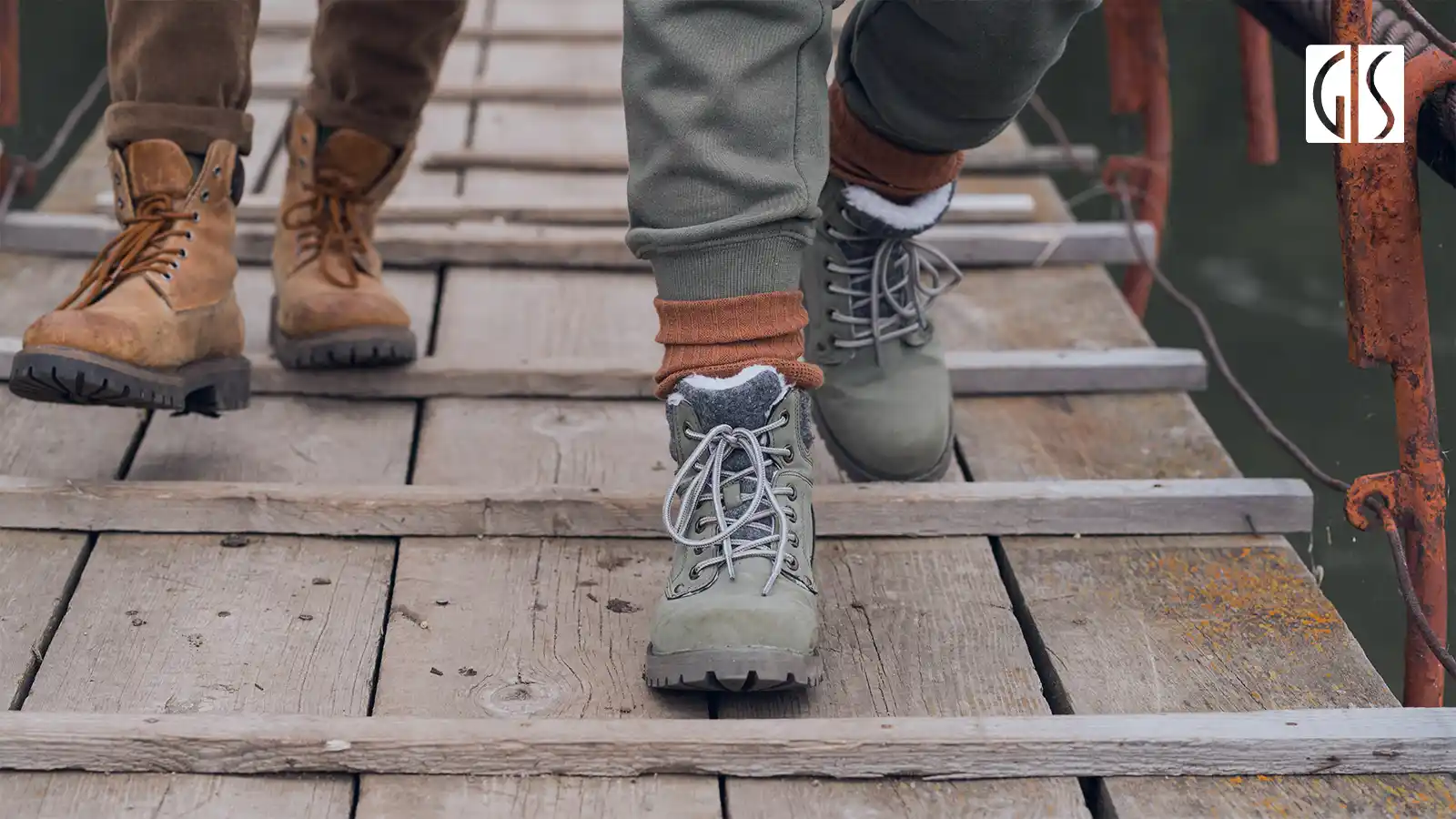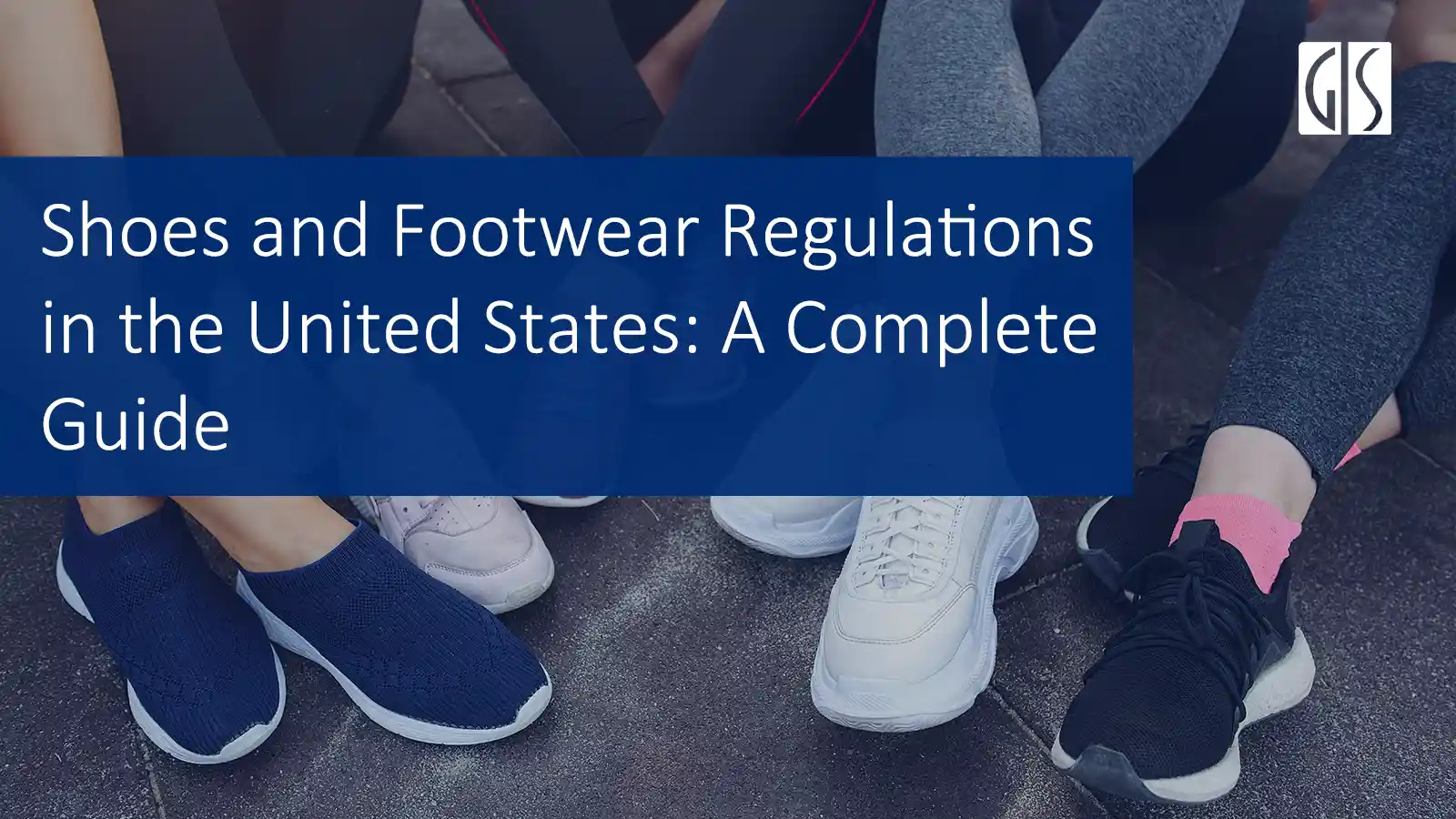Footwear imported or manufactured in the United States must comply with regulations, standards, substance restrictions, labeling, and testing requirements, with additional rules applying to protective and children’s footwear.
In this article, we discover what you need to know about the ASTM Standard for footwear, children’s shoes standard, safety footwear standard, and other compliance requirements for footwear.
Content
ASTM Standards: Footwear
The ASTM standards for footwear
- ASTM F2232 – Standard Test Method for Determining the Longitudinal Load Required to Detach High Heels from Footwear
- ASTM F2892 – Standard Specification for Performance Requirements for Soft Toe Protective Footwear (Non-Safety / Non-Protective Toe)
- ASTM F1818 – Standard Specification for Foot Protection for Chainsaw Users
- ASTM F539 – Standard Practice for Fitting Athletic Footwear
- ASTM F1117 – Standard Specification for Dielectric Footwear
Different Requirements for Footwear
ASTM footwear standards have different requirements that depend on the type of footwear and its intended purpose.
The following are different requirements in the standards above:
- ASTM F2232: Proper performance of this test method requires the height of the footwear’s heel to be 20 mm (13/16 in.) or more
- ASTM F2892: This specification requires footwear devices to be puncture resistant
- ASTM F1818: This standard requires foot protective devices to be resistant to cuts by power chainsaws
- ASTM F539: This standard requires athletic footwear, such as those for running, tennis, and basketball, to properly fit the wearer
- ASTM F1117: This standard requires dielectric overfoot and overshoe footwear to provide the wearer with added insulation and isolation
CPSIA: Children’s Footwear
The Consumer Product Safety Improvement Act (CPSIA) covers children’s products, including footwear for children of 12 years or younger. Ensuring CPSIA compliance involves lab testing, the creation of a tracking label and a children’s product certificate (CPC).
Requirements
The CPSIA generally requires importers and manufacturers of children’s products, including children’s footwear to:
- Ensure said products comply with relevant children’s product safety rules
- Send their products for compliance testing at a CPSC-accepted accredited lab
- Provide a written Children’s Product Certificate (CPC) as evidence of compliance
- Place a permanent tracking label on the product
Safety Shoes and Work Footwear: OSHA
The Occupational Safety and Health Administration (OSHA) sets standards for safety in the workplace. When it comes to safety footwear, OSHA doesn’t have specific standards for boots, but they do require employers to provide their employees with protective footwear when necessary to protect them from hazards such as falling objects, electrical hazards, and slips and falls. It’s important to note that OSHA’s regulations are minimum requirements and employers are encouraged to go above and beyond these requirements to ensure the safety of their employees.
Employers must provide personal protective equipment (PPE), such as workers’ shoes, gloves, and protective garments, to the employees at worksites that might pose physical threats to them.
The Occupational Safety and Health Administration (OSHA) requires employers to provide protective footwear to employees when working in areas that might present potential hazards and could lead to consequences such as the following:
- Foot injuries caused by objects that can fall, roll, or pierce the sole
- Dangers including electric shock or static discharge
The OSHA mandates that protective footwear must comply with one or more of the following consensus standards:
- ASTM F2412 – Standard Test Methods for Foot Protection, which is incorporated by reference in 29 CFR 1910.6 for 29 CFR 1910.136;
- ASTM F2413 – Standard Specification for Performance Requirements for Protective Footwear, which is incorporated by reference in in 29 CFR 1910.6 for 29 CFR 1910.136;
It’s worth noting that ASTM F2412 standard is different from ASTM F2413 standard. ASTM F2412 standard is for impact and compression resistance for safety footwear, while ASTM F2413 standard covers additional safety requirements such as metatarsal and electrical hazards.

ASTM F2412 – Standard Test Methods for Foot Protection
ASTM F2412-24 is the Standard Test Methods for Foot Protection. ASTM F2412 covers the methods to measure the resistance of footwear to a variety of hazards that can potentially result in injury and be used to test for compliance to minimum performance requirements in established safety standards.
By agreement between the purchaser and the supplier, or as required by established safety standards, these test methods can be used to determine any one, or all of the following:
- impact resistance (I),
- compression resistance (C),
- metatarsal impact resistance (Mt),
- resistance to electrical conductivity (Cd),
- resistance to electric hazard (EH),
- static dissipative performance (SD),
- puncture resistance (PR).
ASTM F2413 – Standard Specification for Performance Requirements for Protective Footwear
ASTM F2413 – 24: Standard Specification for Performance Requirements for Protective (Safety) Toe Cap Footwear covers the minimum design, performance, testing, and classification requirements, and prescribes fit, function, and performance criteria for footwear designed to be worn to provide protection against a variety of workplace hazards that can potentially result in injury.
ASTM F2413 encompasses an array of safety features, including impact resistance, compression resistance, metatarsal protection, puncture resistance, electric hazard protection, slip resistance, and sole durability.
Manufacturers, distributors, and end-users of safety footwear are encouraged to comply with ASTM-F2413-24 to ensure that their products or the products they use meet the stringent safety requirements for workplace footwear.
Learn more: ASTM-F2413-24: Safety Standard for Protective Footwear
Standard for the Flammability of Clothing Textiles (16 CFR Part 1610)
The Flammable Fabrics Act (FFA) regulates the flammability standards for the clothing textiles, vinyl plastic film, carpets and rugs, children's sleepwear and mattresses and mattress pads.
16 CFR Part 1610 – Standard for the Flammability of Clothing Textiles
16 CFR Part 1610 sets up flammability testing standards, methods, and performance requirements for textile clothing products. It is designed to keep dangerously flammable textiles and garments made of these textiles out of commerce.
Wearing apparel includes any costume or article of clothing that people wear. The regulation-16 CFR part 1610 applies to all wearing apparel including some types of footwear.
In addition to other products, 16 CFR Part 1610 covers footwear that is:
- Made entirely or partially of hosiery or
- Attached to a piece of clothing
16 CFR § 1610.4 specifies testing procedures to determine the flammability of textiles used in apparel as one of three classes of flammability. Specimens cut into 2-inch by 6-inch swatches must be tested to determine the class and hazard rating.
- Class 1 -textiles are plain surface and raised surface fabrics that exhibit normal flammability and are acceptable for use in wearing apparel.
- Class 2 - textiles are raised surface fabrics that exhibit intermediate flammability and should be used with caution for wearing apparel. This class is not applicable to plain surface fabrics.
- Class 3 - textiles are plain surface and raised surface fabrics that are dangerously flammable and shall not be used in wearing apparel.
Footwear Labeling
This covers some labeling regulations that apply to footwear, such as the Country of Origin mark. Note that some of these regulations only apply to certain types of footwear.
Guides for Select Leather and Imitation Leather Products (16 CFR Part 24)
If your imported footwear includes leather parts, they fall under the scope of the FTC’s 16 CFR Part 24, which regulates the labeling of leather products. According to the regulation, it is considered misleading to inaccurately specify the leather type, including but not limited to the following:
- Kind
- Grade
- Quality
- Material content
- Thickness
- Durability
Non-genuine leather
For example, if the leather shoes are made of non-genuine leather materials, you should specify on the product label or instructions that the shoes are not made of leather, by using terms such as the following:
- Not leather
- Imitation leather
- Simulated leather
- Vinyl
- Vinyl-coated fabric
- Plastic
Additionally, importers should exercise caution when describing leather shoes to avoid misleading the buyer, by using terms such as the following:
- Waterproof
- Dustproof
- Warp proof
- Scuff proof
- Scratch proof
- Scuff resistant
- Scratch-resistant
For more detailed information, you can check FTC’s guidelines on leather labeling.
Rules and Regulations Under the Wool Products Labeling Act (16 CFR Part 330)
16 CFR Part 300 – the Wool Products Labeling Act – covers products that contain wool, including slippers. Note that the act does not cover other types of footwear.
The Act requires covered wool products to have labels that carry information such as the following:
- Fiber content (e.g. “98% wool 2% nylon”)
- Registered identification numbers
- Name of manufacturer and business
Country of Origin Marking (19 CFR Part 134)
19 CFR Part 134 requires that products sold in the US market must have labels indicating their country of origin. The mark for the country of origin must be permanently printed, stamped, or otherwise affixed to the product or its packaging, instead of merely displayed on a sticker.
Examples
- Made in China
- Made in Vietnam
- Made in Malaysia
- Made in India
- Made in Mexico
Label file
It is necessary to create a file specifically for the document of the country of origin and share it with your manufacturer before mass-producing your product. We recommend that you use .ai or .eps formats when creating the file.
Made in USA Labeling Rule (16 CFR Part 323)
The term “Made in the United States” applies to, and should appear on labels of, products of US origin.
16 CFR Part 323 prohibits unfair or deceptive labeling practices insofar as describing a product as “Made in the United States” when said product was not made in the USA. According to the CFR, products should only bear the label “Made in the United States” under the following circumstances:
- The product was processed or fully assembled in the United States
- A significant amount of product processing occurred in the United States
- All ingredients or parts of the product were produced and sourced within the United States
Footwear Product Packaging
Footwear products in the United States must be packaged per relevant rules and regulations, such as the Uniform Packaging and Labeling Regulation (UPLR) and the Model Toxics in Packaging Legislation.
Uniform Packaging and Labeling Regulation (UPLR)
The UPLR has been adopted by most states in the US and covers several product categories, one of them being footwear. The UPLR requires the provision of labeling content such as the following:
- Declaration of identity (e.g. product name)
- Declaration of responsibility (e.g. manufacturer name and address)
- Declaration of quantity
The regulation has several other requirements, such as the following:
- The quantity declaration label should take up the bottom 30% of the display panel
- The display panel size should be calculated by multiplying the package’s height by its depth
- The lettering should be conspicuous
- The color of the information should contrast with its background
GIS Quality Control Inspection Services in Footwear Industry
GIS Inspection is a leading third-party quality control and quality assurance agency in China. We can be your reliable quality control partner conducting audits and footwear inspections on your behalf to save your time and money by quickly identifying and addressing potential defects before they escalate, reducing costly delays and ensuring compliance with industry standards.
GIS has a strong network of 200+ well trained full-time inspectors and auditors. Contact us today to learn more about our footwear inspection and testing services.
----------------------------------------------------------------
Sources:
Several U.S. federal agencies administer regulations associated with footwear.
- Consumer Product Safety Commission (CPSC): Children’s footwear; hazardous substances
- Customs and Border Protection (CBP) : Country of origin for most imported products
- Federal Trade Commission (FTC): Labeling
- Occupational Health and Safety Administration (OSHA): Protective footwear
- United States Department of Agriculture (USDA): Organic claims
Inspect by GIS Inspection
General Inspection Service-GIS is an international third-party quality control inspection company headquartered in China in 2005, which provides a professional range of product quality inspection and factory audit services to clients across multiple industries. We have set up an inspection network covering China, Vietnam, India and Malaysia. By employing only full-time inspectors, GIS is trusted by more than 12,000 brands globally.


